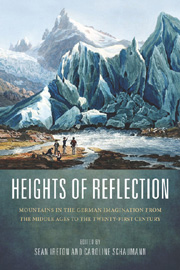 Heights of Reflection
Heights of Reflection Book contents
- Frontmatter
- Contents
- Acknowledgments
- Introduction: The Meaning of Mountains: Geology, History, Culture
- Prelude: Classical Mountain Landscapes and the Language of Ascent
- Part I First Forays: Mountain Exploration and Celebration from the Middle Ages to the Eighteenth Century
- Terra Incognita? Mountains in Medieval and Early Modern German Literature
- From Meadows to Mountaintops: Albrecht von Haller's “Die Alpen”
- Interlude: Geo-Poetics: The Alpine Sublime in Art and Literature, 1779–1860
- Time and Narrative in the Mountain Sublime around 1800
- Faust's Mountains: An Ecocritical Reading of Goethe's Tragedy and Science
- Spectacular Scenery and Slippery Descents: Narrating the Mountains of Tropical Polynesia
- Part II Beckoning Heights: Summits Near and Far in the Nineteenth Century
- Part III Modern Expeditions and Evocations: Climbing from the Twentieth into the Twenty-First Century
- Works Cited
- Notes on the Contributors
- Index
Terra Incognita? Mountains in Medieval and Early Modern German Literature
from Part I - First Forays: Mountain Exploration and Celebration from the Middle Ages to the Eighteenth Century
Published online by Cambridge University Press: 05 February 2013
- Frontmatter
- Contents
- Acknowledgments
- Introduction: The Meaning of Mountains: Geology, History, Culture
- Prelude: Classical Mountain Landscapes and the Language of Ascent
- Part I First Forays: Mountain Exploration and Celebration from the Middle Ages to the Eighteenth Century
- Terra Incognita? Mountains in Medieval and Early Modern German Literature
- From Meadows to Mountaintops: Albrecht von Haller's “Die Alpen”
- Interlude: Geo-Poetics: The Alpine Sublime in Art and Literature, 1779–1860
- Time and Narrative in the Mountain Sublime around 1800
- Faust's Mountains: An Ecocritical Reading of Goethe's Tragedy and Science
- Spectacular Scenery and Slippery Descents: Narrating the Mountains of Tropical Polynesia
- Part II Beckoning Heights: Summits Near and Far in the Nineteenth Century
- Part III Modern Expeditions and Evocations: Climbing from the Twentieth into the Twenty-First Century
- Works Cited
- Notes on the Contributors
- Index
Summary
In the Middle Ages wild nature outside the courtly, aristocratic precinct, where it was delicately tamed and regulated in the garden, always seems to have represented a dangerous, uncivilized, uncanny, if not threatening territory. We hardly ever hear of any poet expressing his or her delight in simple nature scenes, unless these provided safe haven for lovers, such as the delightful meadow at the edge of the forest in Walther von der Vogelweide's famous poem “Under der linden” (Under the linden tree, ca. 1200). In Gottfried von Straßburg's romance Tristan (ca. 1210), Tristan and Isolde escape to their love cave when their existence at King Mark's castle has become intolerable, but that utopian space is situated in a remote forest where dangerous animals roam and human existence is possible only because the two lovers can withdraw into that magical grotto, nourished only by their mysterious love. The forest proves to be the space of lawlessness, the domain of robbers, giants, dwarfs, and other uncanny creatures. The same applies to the mountain, about which poets rarely reported positive aspects, and which appears to have evoked primarily negative feelings even among chroniclers and artists. Not surprisingly, we often observe the metaphoric use of the mountain as a space of hostility and extra-territoriality, hence as a threat to and danger for human existence.
- Type
- Chapter
- Information
- Heights of ReflectionMountains in the German Imagination from the Middle Ages to the Twenty-First Century, pp. 35 - 56Publisher: Boydell & BrewerPrint publication year: 2012


